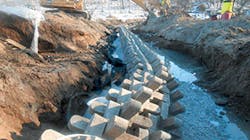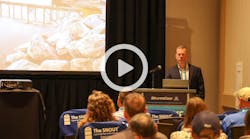Channel Stabilization and Repair Along Streambanks
Channel stabilization and repair along streambanks and other waterways usually calls for the use of a channel lining. Safeguards fall into two major categories—soft and hard.
Soft armor, also referred to as flexible or green techniques, consist of grass or vegetation that is established with the help of erosion control blankets, turf reinforcement mats, or geogrids filled with soil. Grass channels that prevent erosion can be installed with little difficulty and are rather easy to maintain.
When the velocity of water flowing through a channel is greater than a vegetated lining can withstand on its own, however, hard armor such as riprap, concrete, or geosynthetic channel linings may be used. This hard armor, being inflexible and not allowing water to infiltrate, can also increase the velocity of flow.
Installing hard armor requires consideration of compaction, proper installation materials, and bedding. To prevent scour and undercutting, materials may be anchored down in a variety of ways.
Many states have regulations regarding widening a stream channel, straightening a stream, dredging, building permanent structures like docks and boat loading ramps, altering any wetland, putting in utility crossings, or any type of streambank stabilization. Permits are required and it is recommended that an experienced professional designs the system.
Check out Forester Media’s directory for detailed information from our partners in erosion control: erosion control devices, geosynthetics, sediment control devices and soil erosion. For additional information from our erosion control partners, visit our Erosion Control Directory.
Basic Flow Calculations and Manning’s Equation
When engineers design for an open channel, ditch, or swale, they use basic flow computations, including Manning’s Equation. The problem is that Manning’s Equation assumes a constant uniform flow rate at a specified slope. There are many configurations that can alter this assumption. The downstream flow restrictions and how the channel bends will alter the constancy, along with any inconsistencies in the channel width or slope. Man-made structures in a river can alter the flow rate, such as culvert entrance and exit losses and headwaters at culverts or bridges. Basically, anything uneven or unexpected adds to the difficulty of using Manning’s Equation.
Therefore, except for educational purposes or developing a rough estimate, one of the environmental planning or engineering programs should be used instead. The US Army Corps of Engineers has developed several water surface profile programs that can handle variations in natural flow values (HEC-2 or HEC-RAS). Other agencies like the Natural Resources Conservation Service (NRCS) have programs used for basic flow computations.
Erosion Control and Channel Stabilization
There will always be limitations that will affect a design. Designers need to consider whether the streambanks are in a location where they can be easily maintained or inspected. Soft or flexible linings tend to need more maintenance and must be inspected more often to ensure they’re not damaged or overstressed. On the other hand, hard or more permanent channel linings can result in loss of habitat. In spite of the best-laid plans, hard armor can also be damaged due to settlement, scour, or undercutting.
The depth of a channel lining and providing the correct coverage will help prevent erosion and encourage good plant establishment. Channel bottom erosion can be the result of channel grade and liner not being appropriate for the amount of runoff. Although riprap seems fairly “bullet proof”, so to speak, a steep slope not accounted for correctly, or riprap too small for the job, can cause shift to occur, obstructing channels or even creating further damage.


